I am leaning on
https://permies.com/t/66024/Swales-heavy-clay-soil
I have heavy clay soil.
On a north facing slope, we would expect swales to on average run east-west, but landscape could provide features such that a swale happened to north-south for a "short" distance. But, lets say the swales are mostly running east-west. If a person was to plant a row of trees on the berm (downhill) side of a swale, that row of trees would be running east-west as well.
As part of a deer/wind control strategy, I will have a dense hedge running north-south (the wind being more or less from the west). The distance between plants in the hedge is smaller than a swale can be, so there is no way to have a swale "cross" the hedge.
What I am looking for, and so far not finding, is some "rule" on how close one should bring water to the centre of a tree. The tree to be planted as a seedling, so it will direct its roots to grow as it knows best. Whatever that is. I am thinking that the appropriate distance for a 1 year old tree of most species might be as close as 12 inches, but as the tree gets older, you probably want to fill in some of the swale closest to the tree.
---
Perhaps a simpler problem to start with.
The largest trees I have planted so far, are (potentially) Bur oak. This seems to be a tree which is about as wide as it is tall. My oldest Bur oak has been here 2 seasons, so it is 3 years old. It hardly grew this last season, as I understand things it is spending all its energy building a root system. People might plant a Bur oak into the berm of a swale, which would put the oak maybe 5 feet from the water in the swale? And that would never change, the tree would do what with its roots? I suspect it might send some roots deep below the swale to the other side. But at times those roots would be in soil saturated in water. Certainly more so than a tree planted just in a field.
---
On to the more difficult problem.
Having spent too many years doing math, the following is a "rule" I made up with no theory to justify it.
I am expecting the hedge to get to about 20 feet tall (certainly more than 13). And the plants should be about 6 inch diameter at that point, but will get thicker with additional time. By and large, if one assumes that the plant is "square" (as tall as it is wide), it is a place to start. So, the plant is 20 feet tall and 20 feet from dripline to dripline (perpendicular to the line of the hedge). Perhaps the diameter of the plant when it gets to 20 foot tall is the scaling factor for distance, so the plant is 40 "units" wide.
I have no reason to pick a scaling law of the 1/2 power (square root), but the square root of 40 about 6 and 1/3, and converting 6 and 1/3 units to distance, I get 3 foot 2 inches. So, I build my swales to come to 3 foot 2 inch away from the trunk when it first hits 20 feet, which would be 3 foot 5 inches from the centre of the hedge.
A couple of years later, I find the hedge plants are now 9 inches thick. Perhaps the plants are now 22 feet wide. The plant is now 29 1/3 units (a unit is now 9 inches) wide, and using my scaling law I see I want the swale to start at 5 foot 1.5 inches from the centre of the hedge, instead 3 foot 5 inches. So, perhaps I should fill the 1 foot 8.5 inches of swale closest to the hedge line?
Comments? References to papers on this?
Have a great day!

 1
1

















 If you have ideas, by all means present them.
If you have ideas, by all means present them.



































